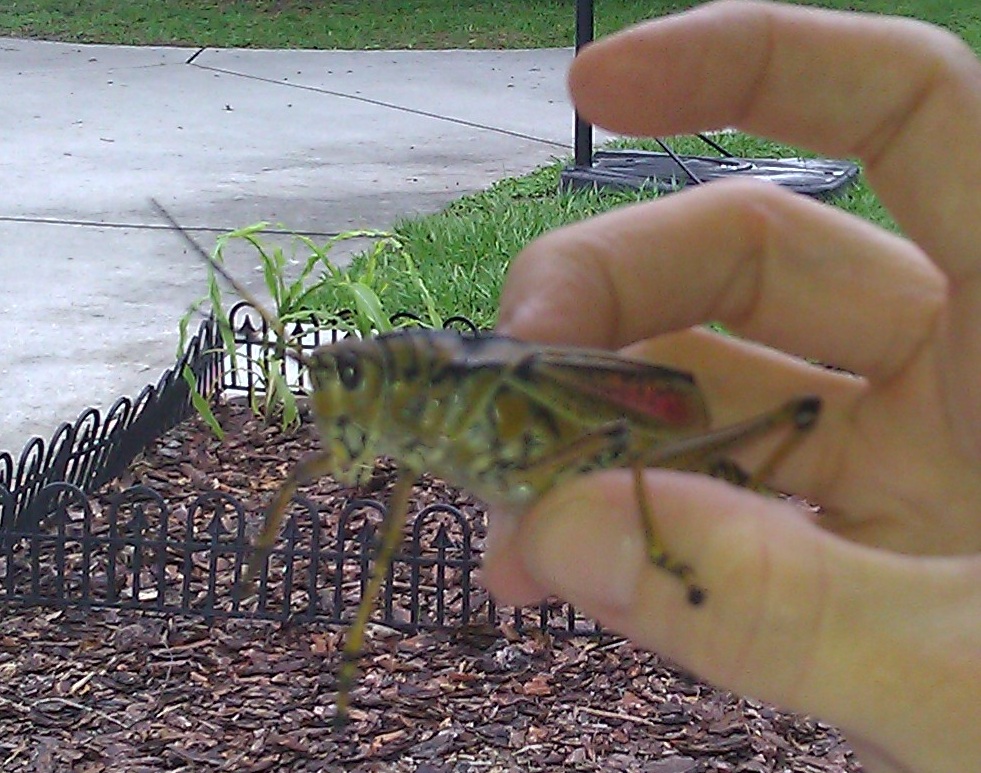 It started with a few small holes. The next day, entire leaves were shredded .
It started with a few small holes. The next day, entire leaves were shredded .
Something was munching down on my broom corn plants!
At first, I thought it might be caterpillars. I carefully lifted each corn leaf strand to see if any insects were lurking underneath.
Nothing.
What in the world? I couldn’t find any insects of any kind on my corn.
How do you fight an enemy you can’t see or identify? At that point, I had no idea what to do.
Luckily, by chance a few hours later, I noticed a huge grasshopper munching on my fiddle leaf fig tree on the front porch.
Lubber Grasshopper Invasion
Florida is home to the huge, rainbow colored lubber grasshopper. Adults regularly grow to 4 inches long.
They hiss and secrete a smelly spray when you try to pick them up. I haven’t been bit by one yet, though.
Literally nothing seems to want to eat them, including my backyard chickens which love large insects in general. They will even fight each other for regular sized grasshoppers. Once I dropped a lubber right in front of them. They just waddled away!
With no natural predators, these grasshoppers munch pretty much anything they like and broad leaf plants are their favorites.
Mmm, I wondered if this critter had been munching my corn?
The best way to get rid of lubber grasshoppers is to either drown them in soapy water or stomp on them.
Pesticides don’t really work although I wouldn’t go that route anyway.
I could only find two lubbers hanging around my front yard, so they both got stomped including the one in the picture above.
Since then, my corn plants have put out some new leaves and so far they remain free of any munch marks.
Since lubber grasshoppers are seasonal critters and not particularly plentiful this summer, hopefully I’ve seen the last one for awhile. I still can’t figure out why they don’t try munching my banana trees though. They have very broad and inviting leaves.








OK, that big grasshopper is totally icky. I lost about 10 seedlings one afternoon, they had just started to show their true leaves. It’s still a mystery since they were in containers on the deck. Some kind of worm is a possibility, but I have another theory. My full grown 4 lb iguana was hanging out in the back yard and sometimes she grazes on the foliage. It’s cute when it’s the Nastertium leaves, it’s another when she eats MY future lunch. I can’t squash her, I just moved the seedlings higher so she can’t reach them, so far so good.
those suckers are all over my backyard…they camp out on my back sliders…the kids think they’re amazing
They are really useful for teaching your kids the parts of an insect’s body because they are so big and easy to see!
I had these on my okra plants last summer. From what I could tell, they didn’t do any damage to the plant.
Chickens, ducks and other birds won’t even eat these things because of the toxic substance they excrete. Best way to get rid of them is to get them when they are little black lubbers…when you see hundreds of them on tall plants and grass go in and smash ’em. I also keep a small hand shovel outside and use it to flick them off plants then chop them in half. I can’t stand the feel of them crunching under my shoes (and then lifting my shoe to see the darn thing didn’t die).
Fry ’em up in some virgin coconut oil and a little salt. Then again, you’d need a whole lot of them to make it worthwhile.
The Lubber grasshoppers love Amaryllis leaves, it is their first choice. Plant Amaryllis bulbs and you can eliminate most of the damage to other plants. Check the Amaryllis often, if Lubbers are going to be a problem you can catch them on those leaves before they get to the garden or your cut flowers.
Cotton farmers I know on the Texas high plains plant rows of blackeyed peas among the cotton rows. Aphids like the peas better and stay mostly off the cotton, less pesticides and money spent on pesticides. Aphids win and cotton wins and farmer wins, perfect solution.
Ugh…that photo made my skin crawl. I’m not bug phobic but there’s something about the way a grasshopper feels on my skin that turns my spine to glass.
In Uganda, grasshoppers fried up in some oil with garlic is a seasonal delicacy!
we get portuguse millipedes in plague here! I’d eat grasshopper… but NOT millipedes!! ug!! LOL
Sometimes you can stomp these giants and they still hop away. The Fla sand isn’t always solid enough to make it easy. I keep a pair of scissors in my garden box, then I sneak up and lop off their heads. They seem to look at your hand and not the scissor blade. Don’t be surprised if they still jump away but they can’t live without their head. It works on the smaller garden variety as well.